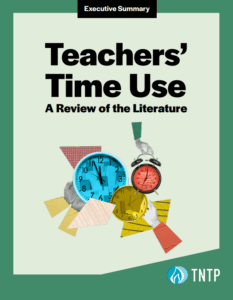Editor’s note: This post was originally published in District Administration. For more practical ideas on recruiting and retaining teachers now and over the long run, read our new guide, Addressing Teacher Shortages.
***
Staffing challenges in schools across the country this year have sparked a national conversation about how to bring more people into the teaching profession. But as district leaders consider that important question, they shouldn’t forget an important fact that often goes overlooked amid teacher shortages: the easiest way to fill a teaching vacancy is to prevent it from becoming vacant in the first place. That’s especially true when it comes to the most effective teachers: in my organization’s study on teacher retention, The Irreplaceables, we found that it can take between 6 and 11 hires to find someone of similar quality.
Teachers choose to leave the classroom for many reasons, including some that are beyond the control of individual schools or districts. But principals and district leaders often have more sway over a teacher’s decision to stay or leave than they think. Over the course of 25 years working in schools across the country, TNTP has identified several low- or no-cost strategies that can help schools retain more of their most effective teachers—which we shared in our recent guide to addressing teacher shortages. Here are four of the most promising:
Hold “stay” conversations with your strongest teachers. Simply asking teachers to stay can boost retention. But two-thirds of the top teachers we surveyed in The Irreplaceables said nobody in their school had encouraged them to return. Principals should hold stay conversations with all effective and promising teachers as soon as possible, making clear that they are valued members of the community and that the school’s leadership team wants them to stay. If teachers say they’re considering other options, principals should ask what they can do to convince them to stay—a crucial step, since our research showed that more than 75 percent of top teachers who left their positions would have stayed if their main reason for leaving were addressed. (This resource can help principals plan for effective stay conversations.)
Don’t make teachers go it alone. Teaching is hard, and the burdens of non-instructional responsibilities on top of the stress and pain of the pandemic have made teaching a lonely and exhausting job. Teamwork is more important than ever—whether that means breaking down the one teacher, one classroom model, creating teacher teams, or strengthening grade-level teams and PLC structures. Help your teachers do their work in the greater community. Create an instructional culture and actual differentiated roles that don’t have teachers fighting an uphill battle alone.
Survey teachers regularly. Surveys give school staff an opportunity to share their feedback, ideas, and concerns. Leaders should then engage staff around the results and actions they’re taking. These surveys don’t have to be long or complicated. For example, we recently partnered with Edgewood Independent School District to implement a 30-second survey designed to provide actionable, real-time information about teachers’ experiences. Every other week, teachers would receive a survey with three questions:
- How are you feeling about your work?
- Is there anything you’d like to share about how you’re feeling or how your work is going?
- What supports/resources would make work easier for you?
This survey data helped leaders in Edgewood identify both school-wide concerns and specific teachers who were in danger of leaving—which helped them prioritize stay conversations and other follow up.
Celebrate great teaching. It’s never been more important to recognize teachers’ accomplishments and their impact on students. Here’s a sample email a school leader could share to recognize excellent instruction. Leaders should also consider engaging local media to share stories about teachers’ dedication and hard work during these especially tough times.
When it comes to navigating such a difficult staffing environment, district leaders should remember that “an ounce of prevention is worth a pound of cure.” Focusing on simple, proven retention strategies can help reduce the burden on recruitment staff and ensure schools have the teachers they need to support every student at this critical moment.








